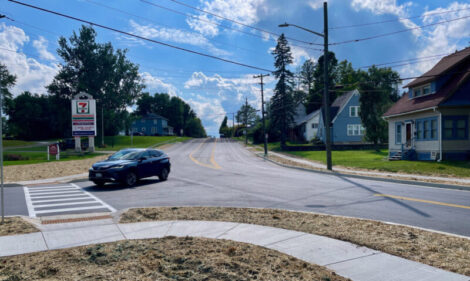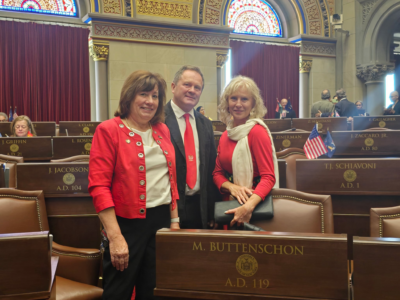Nuclear Energy Options For NRG To Be Examined
Next month, some experts will be meeting with select Chautauqua County lawmakers regarding the possibility of using the former NRG plant as a micro-nuclear energy site.
To prepare for that meeting, the county’s Department of Planning has developed a resource guide regarding nuclear energy.
This week, the county legislature’s Planning and Economic Development Committee received an eight-page “Nuclear Energy Resource Guide” from the Department of Planning. Each page, when viewed electronically, is linked to numerous sources, giving background.
Some the topics the guide addresses include: defining nuclear energy, the need for next generation alternative renewable energy sources, status of microreactor nuclear technology development, the regulatory environment, projects currently in development around the world, pros and cons of small modular reactors and microreactors as power sources, and the status of repurposing/repowering the NRG Dunkirk station.
The section on the status of repurposing/repowering NRG has a link to Phase I NRG Power Plant Feasibility Study and Alternatives Analysis. That was originally published in June, 2021.
A Phase II and a “white paper” which will offer a realistic approach to the reuse of NRG site by repowering with Small Modular Reactors with natural gas as a bridge, are in process but currently incomplete.
County Planning and Economic Development Director Mark Geise said both the “white paper” and Phase II documents should be available soon. The New York State Energy Research and Development Authority has some final comments before the Phase II document will be available for review.
Geise said in July a professor from the University at Buffalo, who is an expert in nuclear energy, will be at the legislature’s Planning and Economic Development Committee meeting, along with a representative from Phillips Lytle.
WHAT ARE SMALL MODULAR REACTORS
Small modular reactors (SMRs) are advanced nuclear reactors that have a power capacity of up to 300 MWe per unit. This is about one-third of the generating capacity of traditional nuclear power reactors.
SMRs, which can produce a large amount of low-carbon electricity, are:
– Small – physically a fraction of the size of a conventional nuclear power reactor.
– Modular – making it possible for systems and components to be factory-assembled and transported as a unit to a location for installation.
– Reactors – harnessing nuclear fission to generate heat to produce energy.
The International Atomic Energy Agency, one of the sources cited in the county’s Nuclear Energy Resource Guide, notes that given their smaller footprint, SMRs can be sited on locations not suitable for larger nuclear power plants. Prefabricated units of SMRs can be manufactured and then shipped and installed on site, making them more affordable to build than large power reactors, which are often custom designed for a particular location, sometimes leading to construction delays. SMRs offer savings in cost and construction time, and they can be deployed incrementally to match increasing energy demand.
According to the Atomic Energy Agency, in comparison to existing reactors, proposed SMR designs are generally simpler, and the safety concept for SMRs often relies more on passive systems and inherent safety characteristics of the reactor, such as low power and operating pressure. This means that in such cases no human intervention or external power or force is required to shut down systems, because passive systems rely on physical phenomena, such as natural circulation, convection, gravity and self-pressurization. These increased safety margins, in some cases, eliminate or significantly lower the potential for unsafe releases of radioactivity to the environment and the public in case of an accident.
WHAT IS A MICROREACTOR
Microreactors are not defined by their fuel form or coolant. Instead they have three main features: factory fabricated, transportable, and self-adjusting. While microreactor designs vary, most would be able to produce 1-20 MWe of thermal energy that could be used directly as heat or converted to electric power.
The U.S. Department of Energy, which is also one of the resources cited in the county’s Nuclear Energy Resource Guide, states that microreactor designs vary, but most would be able to produce 1-20 megawatts of thermal energy that could be used directly as heat or converted to electric power. They can be used to generate clean and reliable electricity for commercial use or for non-electric applications such as district heating, water desalination and hydrogen fuel production.
The Department of Energy notes that a handful of microreactor designs are under development in the United States, and could be ready to roll out within the next decade.
These compact reactors will be small enough to transport by truck and could help solve energy challenges in a number of areas, ranging from remote commercial or residential locations to military bases.
NRG AS A POTENTIAL SITE
The NRG power plant has been idle since 2016.
At the Planning and Economic Development Committee meeting, Legislator Fred Larson, D-Jamestown, asked Geise that, following next month’s discussion, would it be worthwhile for the legislature to pass a resolution for NYSERDA to consider the former NRG plant in Dunkirk as a small modular nuclear site.
Geise said he hadn’t thought a lot about the value of a resolution, but added, “It probably makes sense.”
In March During Chautauqua County Executive PJ Wendel’s State of the County address he announced that he would be launching a committee that would explore nuclear opportunities, saying, “I strongly feel that micro-nuclear energy could make Chautauqua County a major electricity producer that would not only meet our community’s energy needs but those in the entire region across New York state.”




